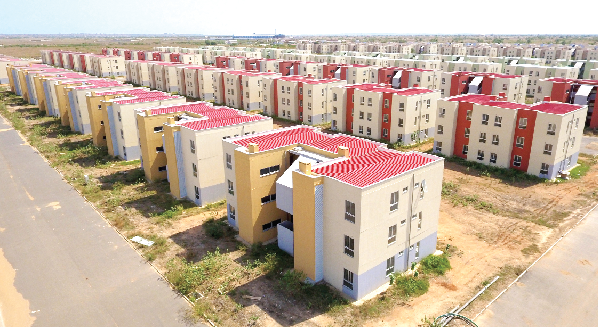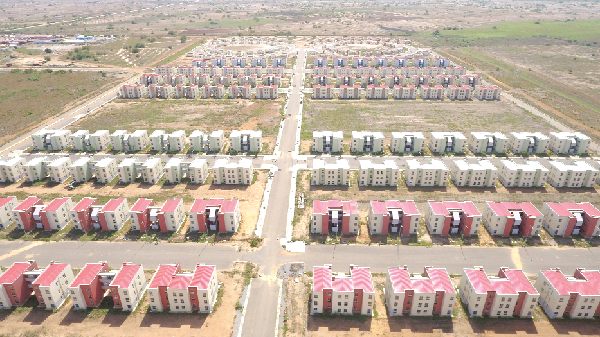Defining a beautiful building
I remember the first time I went to London and just how disappointed I was by how drab most of the buildings and everything looked.
Mind you, we are talking about a long time ago, and at a time when the British were not interested in the outside looks of a building.
You would see this colourless, unattractive brick building and when you enter, you would be surprised at the beautiful interior.
I quickly learnt not to judge a building by its exterior.
Things have changed somewhat these days and it is not only that they have become more adventurous with dramatic architectural designs; they are now even painting the outside of their buildings with bright colours.
We in Ghana have always paid a lot more attention to the outside look of a building, often, without equal attention to the inside.
As the skyline in Accra is changing rapidly, there are many interesting buildings coming up and it does look like the emphasis is still on the outside of the structures and not on the fine details of the finishing.
I do not know if it is a question of a scarcity of skilled artisans or the inability of the professionals in the building industry to exert their influence or do the supervision they are supposed to do; there is a definite lack of aesthete in the workmanship exhibited in most of our modern buildings. The most important consideration seems to be how striking or imposing the building would be.
Last week, I entered a grand, newly constructed office building in an upmarket part of Accra.
It was an impressive looking building and as I approached it, I prepared myself to be awed by all the mod cons that I expected to see. They were there.

List
As is my wont, I brought out in my mind’s eye the list of things which help me make up my mind about whether a building is really high-end or simply pretentious.
If the building is a storey building as most buildings seem to be these days and as they are sure to be if they are office buildings, the first thing on my list to look out for is the staircase.
If you live in Ghana, you need not be told that our builders have a real problem with stairs.
Every time you are faced with a staircase in this country, you take your life in your hands; the steps are never the same height or width and you can never predict what height the next step would be when you have manoeuvred one.
You learn quickly that stairs are the most dangerous part of a storey building in our country.
There is no running up or down a staircase, not if you value your life.
Normally, when climbing up or coming down a flight of stairs, you are supposed to assume that the individual steps are the same height and the same width and you don’t need to watch where you place your feet, but simply take regular steps and you should be fine.
Here, you should be ready to be surprised by every step.
So, I went into this building and tried to go to the first floor where I had my appointment.
The very first step at the beginning of the stairway was unexpectedly very steep, (nothing to do with me being an old woman), the next step was half the height of the first one and on the fourth one, my foot was hanging because the width was different.
I wondered what I would be expected to do if I had to work in this building and had to climb those stairs any number of times every day.
Then I wondered what the people called building inspectors look out for and what they inspect and if it was part of their business to make sure that stairways were fit for purpose and if they had passed this stairway.
I noticed the floor tiles were beautiful and the tiling had been done tastefully. Did the expensive and beautiful tiles make up for the awkward and crude stairs? No.
I looked out for the electrical sockets and as is often the case, you could tell those who fixed them had difficulties with straight lines.
Why can’t we draw and keep to straight lines in the construction industry? I wonder if it is more expensive to keep straight lines and cheaper to have crooked lines.
There must be a good reason, which is not obvious to me, why the fittings in our buildings are hardly ever done in straight lines.
It is not just the sockets. The lights, the windows and door lines are never straight.
The other day, I went to a new residential estate and every door I saw was crooked. No window could be closed properly and the window sills all looked like they had been in violent arguments.
And yet I would have sworn that we as a people like beautiful things. Take a look at our cultural artefacts, at our woven fabrics and at the traditional hairstyles of our women.
The more intricate the designs, the more beautiful they are, or so I thought.

Attitude
But I fear the dzra ho dzi (just wait a moment and I will be done with it) attitude is seeping through to even such otherwise aesthetically pleasing things, and like our grand buildings, many cannot now stand intimate scrutiny.
Once upon a time, it would have been considered sacrilege, but now you can see kente that is very much the fabric equivalent of a stairway of uneven steps.
And we have tailors who make clothes with seams like the crooked banks of electric sockets in our houses.
A beautiful dress should be judged by the fine details of the sewing and not by the colour and design of the fabric.
A kente outfit with a wow factor is judged by the beauty of the weave and the imaginative fine detailing of the sewing.
The problem with not paying attention to the fine details in the construction and fitting of fixture in a building is that there is no joy in inhabiting it and it shows after a year or two.
A beautiful building is or must be pleasing to the eye, outside and inside, and satisfying to those who use it. A beautiful building is not necessarily an expensive building.
And how I wish our building industry professionals will take pride and pleasure in what they produce for us.


